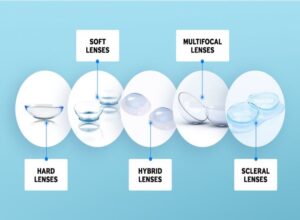Contact lenses are thin, clear plastic disks you wear in your eye to improve your vision. Contacts float on the tear film that covers your cornea.

Contact lenses are thin, clear plastic disks you wear in your eye to improve your vision. Contacts float on the tear film that covers your cornea.
Like eyeglasses, contact lenses correct vision problems caused by refractive errors. A refractive error is when the eye does not refract (bend or focus) light properly into the eye resulting in a blurred image.
The different types of Contact lenses are:
Soft contact lenses are composed of malleable plastic polymers. They are very flexible and, when fit properly, will form to the cornea (the front surface of the eye). They are the most commonly worn type of contact lenses.
Newer RGP lenses offer the advantage of allowing more oxygen to pass through to the eye. They are often referred to as oxygen permeable lenses and are available in daily wear and extended wear options.
Colour deficiency is a condition characterized by colour confusion and the inability to discriminate between certain colours. Their altered colour perception is due to a malfunction in the retina of the trichromatic-three-receptor colour (red, green, and blue) vision system.
X-Chrome contact lens is a red contact lens worn in one eye and is used to overcome red-green colour vision deficiencies.
ts principle is to create what is referred to as retinal rivalry, which results in the brain being able to better distinguish between shades of colour.
As the red contact lens is only carried in one eye(non-dominating eye), the patient can compare different contrasts between the two eyes. The lens is named the “X-Chrome” lens because the gene that causes the problem is carried on the X chromosome
Its principle is to create what is referred to as retinal rivalry, which results in the brain being able to better distinguish between shades of colour.
For children and adults, to eliminate many of the academic challenges with colour-coded learning and teaching materials. In addition, these lenses are ideal for colourblind people who want to improve the quality of many recreational activities.
Scleral contacts are noticeably larger than standard gas permeable (GP) contacts and have a diameter equal to or greater than that of soft contact lenses. The smallest sclerals are approximately 14.5 mm in diameter, and the largest can be up to 24 mm. They are larger than conventional GP lenses, scleral lenses are more stable on the eye. They also provide initial comfort similar to soft lenses.
Generally, anyone interested in achieving the best vision possible with contact lenses can be a candidate for scleral lenses. But scleral GP lenses are particularly helpful for the following conditions:
Coloured contact lenses are the most stylish update of existing versions that allows the instant transformation of the entire appearance of the wearer by changing the colour of the pupil. Modern colour contact lenses are available in a wide range of natural colors that compliment your natural beauty. Contact lenses can be worn by anyone and anywhere, whether at work, any casual event or to a party or Halloween kind of occasions. People also transform their looks with Coloured Lenses. People with vision problems like astigmatism can also wear specially designed toric coloured lenses.
Get in Touch with us for a customised solution for your eyes at the Best Contact Lens Clinic in Mumbai. Call: +91-9820111315